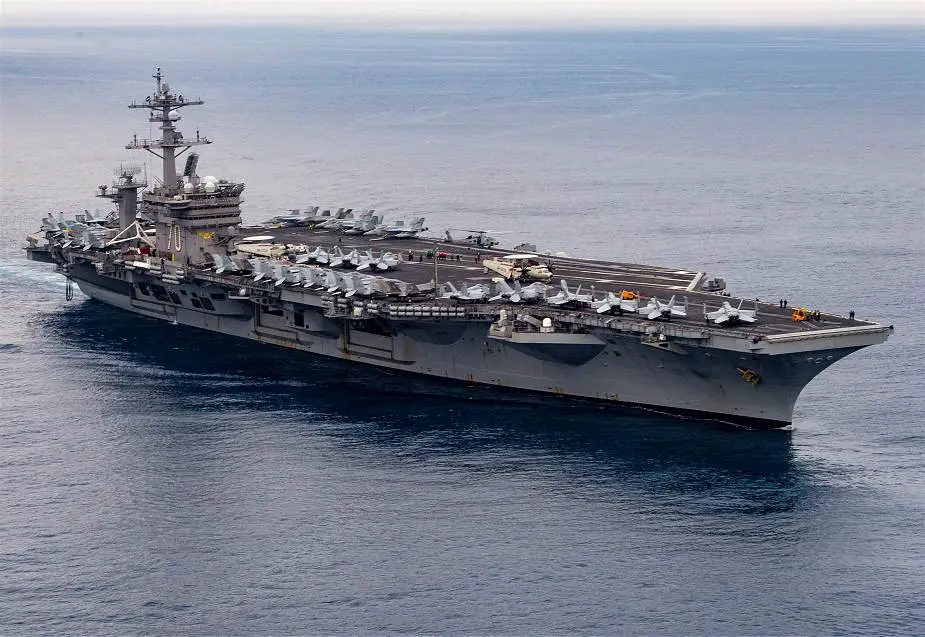Breaking news
US Navy Carl Vinson Carrier Strike Group deployed for the first time with F-35C and CMV-22B Osprey.
According to information published by the U.S. Navy on August 3, 2021, the U.S. Navy Carl Vinson Carrier Strike Group (CVCSG), led by Carrier Strike Group (CSG) 1 is deployed for the first time with the advanced capabilities of the F-35C Lightning II fighter aircraft and U.S. Navy CMV-22B Osprey.
Follow Navy Recognition on Google News at this link
 The CVCSG deployment also marks the first time that a carrier strike group is deploying with the advanced capabilities of the F-35C Lightning II and Navy CMV-22B Osprey. (Picture source U.S. Navy)
The CVCSG deployment also marks the first time that a carrier strike group is deploying with the advanced capabilities of the F-35C Lightning II and Navy CMV-22B Osprey. (Picture source U.S. Navy)
CVCSG (Carl Vinson Carrier Strike Group ) will begin their deployment by taking part in Large Scale Exercise 2021. LSE 2021 is a live, virtual, and constructive, globally-integrated exercise that spans multiple fleets, designed to refine synchronized maritime operations based on a progression of scenarios that will assess modern warfare concepts in support of the joint force.
Less than a year ago, the strike group’s flagship, Nimitz-class nuclear aircraft carrier USS Carl Vinson (CVN 70), completed a 17-month maintenance period and retrofit, during which the ship underwent a complete restoration and system retrofit to accommodate F-35C Lightning II mission capabilities.
The USS Carl Vinson is the first aircraft carrier to accommodate a mix of 4th and 5th generation strike fighters, providing unprecedented lethality and survivability and ensuring the Navy team can operate and win in contested battlespace now and well into the future.
The strike group is a multiplatform team of ships, aircraft and more than 7,000 Sailors, capable of carrying out a wide variety of missions around the globe. Deploying ships and aircraft of the strike group include: USS Carl Vinson (CVN 70); nine squadrons of CVW-2; staffs of CSG 1 and Destroyer Squadron (DESRON) 1; Ticonderoga-class guided-missile cruiser USS Lake Champlain (CG 57); and Arleigh Burke-class guided-missile destroyers of DESRON 1, which include USS Chafee (DDG 90), USS Dewey (DDG 105), USS Higgins (DDG 76), USS Michael Murphy (DDG 112), USS O’Kane (DDG 77) and USS Stockdale (DDG 106).
CVW-2 consists of an F-35C squadron, the “Argonauts” of Strike Fighter Squadron (VFA) 147; three F/A-18E/F Super Hornet squadrons, the “Bounty Hunters” of VFA-2, the “Stingers” of VFA-113, and the “Golden Dragons” of VFA-192; the “Gauntlets” of Electronic Attack Squadron (VAQ) 136, operating the EA-18G Growler; the “Black Eagles” of Airborne Command and Control Squadron (VAW) 113, operating the E-2D Advanced Hawkeye; the “Titans” of Fleet Logistics Multi-Mission Squadron (VRM) 30, operating the CMV-22B Osprey; the “Black Knights” of Helicopter Sea Combat Squadron (HSC) 4, operating the MH-60S Seahawk; and the “Blue Hawks” of Helicopter Maritime Strike Squadron (HSM) 78, operating the MH-60R Seahawk.
The USS Carl Vinson is the third Nimitz-class aircraft carrier of the U.S. Navy. She was commissioned on 13 March 1982 at Newport News, Virginia. On 14 August 2015, Carl Vinson began a planned incremental availability (PIA) period at Naval Air Station North Island. The ship received more than $300 million worth of improvements over six months during this modernization, including the first UAV (Unmanned Aerial Vehicle) command center installed aboard an aircraft carrier. In mid-February 2017, it was reported that the Carl Vinson CSG commenced "routine operations" in the South China Sea. During the first half of April 2017, after conducting training exercises with the Republic of Korea Navy in the Western Pacific.
The USS Carl Vinson can carry more than 65 fixed and rotary-wing aircraft and can travel more than 5,000 nautical miles in less than seven days in support of national tasking.


























